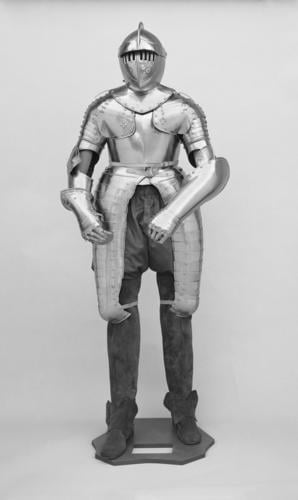-
1 of 253523 objects
Composite cuirassier's armour late sixteenth century to early seventeenth century
Steel | RCIN 72922
St George's Hall, Windsor Castle

Composite cuirassier's armour late sixteenth century to early seventeenth century
-
Composite cuirassier's armour, comprising close helmet of early seventeenth-century Italian make, the skull and bevor in each case formed at their lower ends with integral gorget-plates, and with an associated pivoted peak with partly restored left arm, fitted within its lower edge with a U-shaped faceguard and cut over the eyes with a series of vertical slots separating short bars; gorget formed of a single plate front and rear, authentic but from a pikeman's armour; breastplate of vestigial ‘peascod’ fashion formed in one piece with a flange at its lower edge to receive two knee-length tassets each having straight upper edges to their lames and terminating in poleyns with straight lower ends; backplate from a pikeman’s armour formed in one piece with a flanged lower edge; large slightly rounded symmetrical pauldrons connected by turners to articulated vambraces of late sixteenth-century German make with winged couters that are open at the insides of the elbows; right gauntlet late sixteenth-century Italian with restored metacarpal-plates, knuckle-plate and finger-scales.
North European (partly Dutch and English), early seventeenth century, unless otherwise specified above.
Text adapted from Arms and Armour in the Collection of Her Majesty The Queen: European Armour, London, 2016 -
Medium and techniques
Steel
Category
Object type(s)